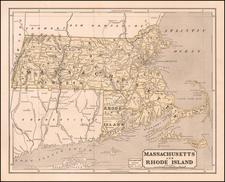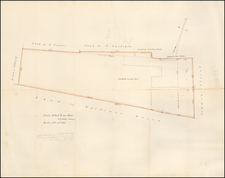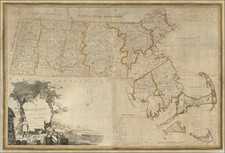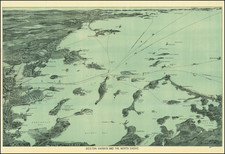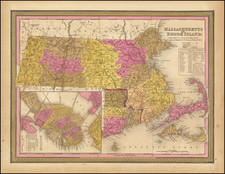Champlain Discovers a Native American Ambush at Present-Day Gloucester, Massachusetts. Can you Spot the Gloucester Sea Serpent?
Original Samuel de Champlain engraved map of the area around what is now Gloucester, Massachusetts, the first such printed map. Burden (168) says of the map "This is one of the best charts in the series..."
Champlain arrived in the area in September 1606, having passed it by first in 1605. The expedition stopped in the area for two nights to determine if it was a suitable place for settlement. A hint as to why the area was rejected can be seen illustrated pictorially on the map; near Smith Cover on the peninsula at the bottom of the map, a small figure can be seen running with his arms flailing about. This is Champlain himself warning Poutrincourt of a potential Indian ambush. Apparently, this interaction led the party to believe that there were too many natives in the area to make it a suitable settlement.
Despite these issues, Champlain thought highly of the area naming it "le Beau port" or The Handsome Port.
The map is oriented with north at the right.
Key Translation
The key translates as follows:
The numbers show the fathoms of water.
A The site where our ship was.
B Prairies.
C Small island.
D Rocky cape
E The site where we calked our boat.
F Small islet of rocks high on the coastline
G Savage's cabins, and where they worked the earth
H Small river with prairies
I Stream
L Spit of land with wood where there are lots of reptiles [?], nut trees, and vines
M A dead end in the sea when turning about the island cape
N Small river
O Small stream coming from the prairies
P Another small stream where we blanched our laundry
Q Savage troops that came to surprise us
R Sandy beach
S The seaside
T Sir de Poutrincourt shot with seven or eight arquebuses
V Sir de Champlain spotted the savages.
Samuel de Champlain
Samuel de Champlain (1470-1535) was one of the greatest explorers and cartographers of his era, and the founding father of what would one day become Canada. Inspired by the voyages of his countryman, Jacques Cartier, he made his first voyage to Canada in 1603. Upon his return to France, his reports encouraged Henry IV to finance a colonizing expedition, and the colonizing company was given a royal monopoly on all settlement and fur trading rights between the 40th and 45th parallels. In 1604, Champlain joined the venture as second in command to Pierre Dugua, the Sieur de Mons, and it was on this voyage that they founded the habitation of Isle de Sainte Croix. The settlers later moved to the more hospitable site of Port Royal (Annapolis Royal, Nova Scotia), while Champlain explored the Massachusetts coast in search of alternate sites. These plans were abandoned due to the hostility of the indigenous Monomoyic tribe.
Within a couple of years, Champlain assumed supreme leadership over the French colonization venture. In 1608, he founded Quebec City on an impressive promontory overlooking the St. Lawrence River. Having overcome much initial adversity, this settlement proved to be successful, becoming the capital of a vast French domain that eventually extended down to the Gulf of Mexico and over to the Rockies.
Champlain, passionately dedicated to the mission of securing the permanence of New France, had to return to France frequently to raise funds and encourage new settlers to join the enterprise. A cornerstone of his campaign was the publication of his greatest work, Les Voyages dv Sieur de Champlain (Paris, 1613), a detailed narrative of the founding of New France, which included the present plan. Champlain later became the governor of New France, and by the time he died on Christmas Day 1635, he knew that he had succeeded in his mission.









